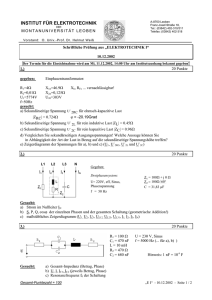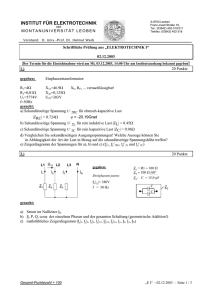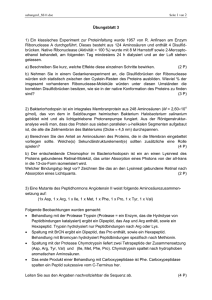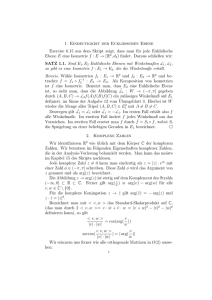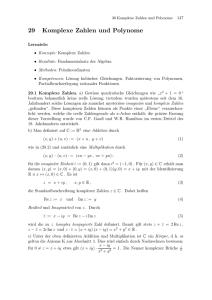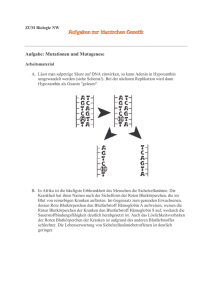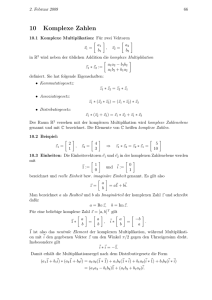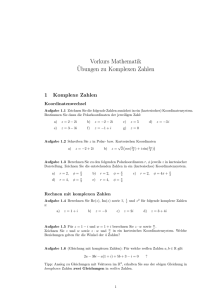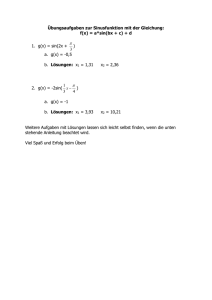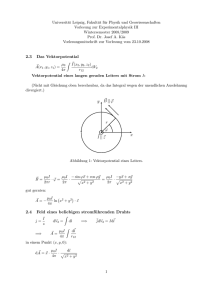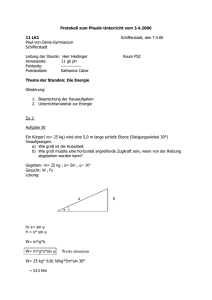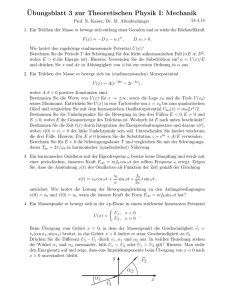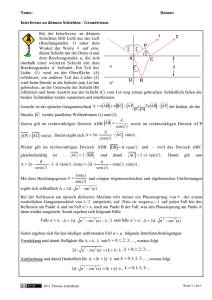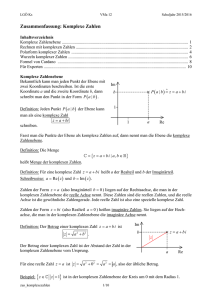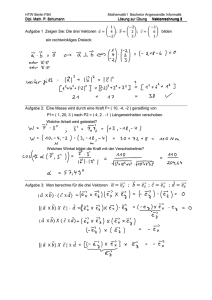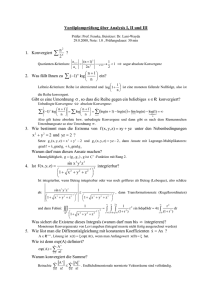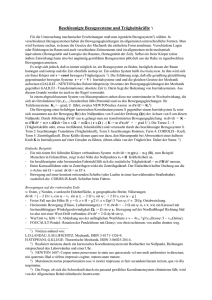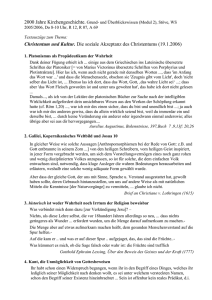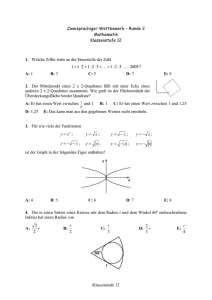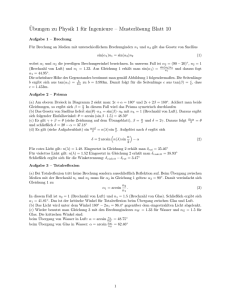Anhang A Beweise der Lemmata 1.1 und 1.2
Werbung
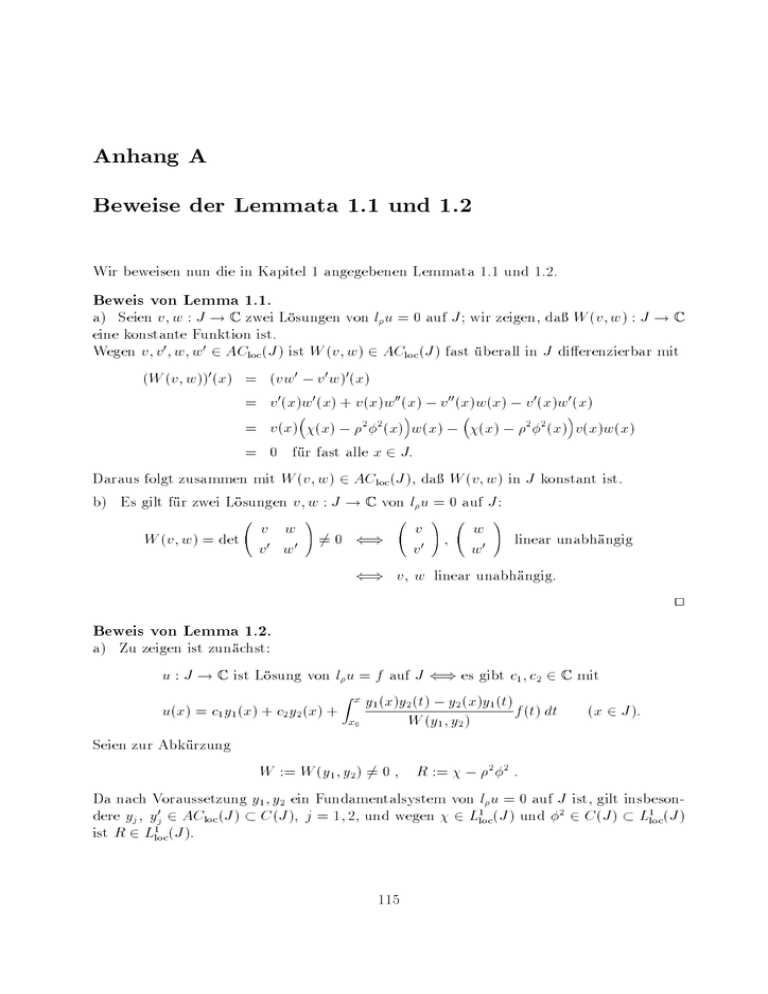
Anhang A
Beweise der Lemmata 1.1 und 1.2
Wir beweisen nun die in Kapitel 1 angegebenen Lemmata 1.1 und 1.2.
Beweis von Lemma 1.1.
a) Seien v; w : J ! C zwei Losungen von l u = 0 auf J ; wir zeigen, da W (v; w) : J ! C
eine konstante Funktion ist.
Wegen v; v0 ; w; w0 2 ACloc (J ) ist W (v; w) 2 ACloc (J ) fast uberall in J dierenzierbar mit
(W (v; w))0 (x) = (vw0 v0 w)0 (x)
= v0 (x)w0 (x) + v(x)w00 (x) v00 (x)w(x) v0 (x)w0 (x)
= v(x) (x) 2 2 (x) w(x) (x) 2 2 (x) v(x)w(x)
= 0 fur fast alle x 2 J:
Daraus folgt zusammen mit W (v; w) 2 ACloc (J ), da W (v; w) in J konstant ist.
b) Es gilt fur zwei Losungen v; w : J ! C von l u = 0 auf J :
!
!
!
v w
v
w
W (v; w) = det v0 0 6= 0 () v0 ; w0 linear unabhangig
w
() v; w linear unabhangig.
2
Beweis von Lemma 1.2.
a) Zu zeigen ist zunachst:
u : J ! C ist Losung von lu = f auf J () es gibt c1; c2 2 C mit
Zx
u(x) = c1y1(x) + c2y2(x) + y1(x)y2W(t)(y ;yy2()x)y1(t) f (t) dt (x 2 J ):
x0
1 2
Seien zur Abkurzung
W := W (y1; y2) 6= 0 ; R := 22 :
Da nach Voraussetzung y1 ; y2 ein Fundamentalsystem von l u = 0 auf J ist, gilt insbesondere yj ; yj0 2 ACloc (J ) C (J ); j = 1; 2, und wegen 2 L1loc (J ) und 2 2 C (J ) L1loc (J )
ist R 2 L1loc (J ).
115
(i) "(=": Es gelte
Z x y1(x)y2(t) y2(x)y1(t)
f (t) dt (x 2 J );
W (y1; y2)
x0
mit c1 ; c2 2 C und fest gewahltem x0 2 J . Wir zeigen:
u; u0 2 ACloc(J );
Zx 0
0
u0(x) = c1y10 (x) + c2y20 (x) + y1(x)y2W(t)(y ;yy2()x)y1(t) f (t) dt (x 2 J );
x0
1 2
u00(x) + R(x)u(x) = f (x) fur fast alle x 2 J:
Aufgrund von f 2 L1loc (J ); yj 2 C (J ) fur j = 1; 2 ist yj f 2 L1loc (J ) und
Z x yj f J ! C; x 7! W 2 ACloc(J ) (j = 1; 2);
x0
zusammen mit yj 2 ACloc (J ) fur j = 1; 2 folgt nach (A.1)
u 2 ACloc(J ):
Daher ist u fast uberall in J dierenzierbar mit (siehe (A.1))
8
Z x y2 f
>
0
0
0
0
>
u (x) = c1y1(x) + c2y2(x) + y1(x) W + y1(x) y2(xW)f (x)
>
x0
>
>
Z
>
x
>
<
y20 (x) yW1f y2(x) y1(xW)f (x)
x0
(A.2) >
Z
Z
>
>
0 (x) + c y 0 (x) + y 0 (x) x y2 f y 0 (x) x y1 f
>
=
c
y
1 1
2 2
1
2
>
x0 W
x0 W
>
>
:
(fast alle x 2 J ):
(A.1)
u(x) = c1y1(x) + c2y2(x) +
Da die rechte Seite von (A.2) lokal absolut stetig und lokal integrierbar auf J ist, gibt es in
der A quivalenzklasse von u0 2 L1loc (J ) einen Reprasentanten, fur den (A.2) fur alle x 2 J
gilt. Daher folgt
u0 2 ACloc(J );
und u0 ist in J fast uberall dierenzierbar mit (siehe (A.2))
8
Z x y2 f
>
00
00
00
00
>
u (x) = c1y1 (x) + c2y2 (x) + y1 (x) W + y10 (x) y2(xW)f (x)
>
x0
>
>
Z
>
x
>
<
y200(x) yW1f y20 (x) y1(xW)f (x)
x0
(A.3) >
Z x y00(x)y2(t) y00(x)y1(t)
>
>
1
2
00
00
>
f (t) dt f (x)
= c1 y1 (x) + c2 y2 (x) +
>
W
x0
>
>
:
(fast alle x 2 J ):
116
Mit (A.1), (A.3) und l yj = 0 auf J , j = 1; 2, veriziert man durch Einsetzen sofort
u00(x) + R(x)u(x) = f (x) (fast alle x 2 J ):
Der Zusatz uber u0 in der Behauptung wurde in (A.2) und der nachfolgenden Argumentation, da (A.2) fur alle x 2 J gilt, bereits bewiesen.
(ii) "=)": Sei u 2 ACloc(J ) mit u0 2 ACloc(J ) und
u00(x) + R(x)u(x) = f (x) (fast alle x 2 J ):
(A.4)
Sei x0 2 J fest gewahlt. Wir zeigen, da c1 ; c2 2 C existieren mit
( )
Z x ( )
u( )(x) = c1y1( )(x) + c2y2( )(x) + y1 (x)y2(t) W y2 (x)y1(t) f (t) dt (x 2 J; = 0; 1):
x0
Dazu transformieren wir (A.4) in ein Dierentialgleichungssystem 1. Ordnung vermoge
u1 := u ; u2 := u0 :
Damit ist (A.4) aquivalent zu
!
!
!
!
!
u1(x) 0
u2(x)
0
1
u1(x)
0
=
=
+
u2(x)
R(x)u1(x) f (x)
R(x) 0
u2(x)
f (x)
(A.5)
(fast alle x 2 J ):
Das zugehorige homogene Dierentialgleichungssystem besitzt nach Voraussetzung die Fundamentalmatrix
!
y1(x) y2(x)
(x) := 0
(x 2 J );
y1(x) y20 (x)
und wegen det (x) = W 6= 0 fur alle x 2 J ist die Matrix (x) fur alle x 2 J invertierbar.
Mit Hilfe der "Variation der Konstanten"geben wir zunachst eine spezielle Losung des
inhomogenen Systems (A.5) an:
!
!
Zx
u1(x)
0
1
= (x) (t)
dt (x 2 J ):
u2(x)
f (t )
x0
Die allgemeine Losung von (A.5) lautet deshalb
!
!
!
Zx
u1(x)
0
c
1
1
= (x)
dt (x 2 J )
c2 + (x) x0 (t)
u2(x)
f (t )
mit c1 ; c2 2 C. Dabei ist nun
!
!
!
Zx
Zx 1
0
y20 (t) y2(t)
0
1
(x) (t)
dt = (x) det (t)
dt
f (t )
y10 (t) y1(t)
f (t )
x0
x0
117
Zx 1
= (x)
x0 W
0
Rx y2f
y
(
x
)
1
W
B
x0
B@
= B
x
y10 (x) xR yW2f
0
!
y2 ( t ) f ( t )
dt
y1(t)f (t)
1
x
R
y1 f
y2(x) x W C
0
CC
x
R
y20 (x) x yW1f A
(x 2 J );
0
so da
0
1
0
1 0
1 B Rx y1(x)y2(t)Wy2(x)y1(t) f (t) dt C
u (x)
c y (x) + c2y2(x)
CC
@ 1 A=@ 1 1
A + BB xRx0 0
0
@
0
0
y
(
x
)
y
(
t
)
y
(
x
)
y
(
t
)
2
1
1
2
u2(x)
c1y1(x) + c2y2(x)
f (t) dt A
W
(x 2 J );
x0
und es folgt:
Z x y1( )(x)y2(t) y2( )(x)y1(t)
f (t) dt
W
x0
b) Nach a) besitzt jede Losung von l u = f auf J die Gestalt
Z x y1( )(x)y2(t) y2( )(x)y1(t)
( )
( )
(
)
f (t) dt
u (x) = c1y1 (x) + c2y2 (x) +
W
x0
mit geeigneten c1 ; c2 2 C. Dann gilt also
u( )(x) = c1y1( )(x) + c2y2( )(x) +
(x 2 J; = 0; 1):
(x 2 J; = 0; 1)
u(x0) = c1y1(x0) + c2y2(x0) = a;
u0(x0) = c1y10 (x0) + c2y20 (x0) = b
genau dann, wenn c1 ; c2 das folgende lineare Gleichungssystem losen:
(A.6)
y1(x0) y2(x0)
y10 (x0) y20 (x0)
!
Wegen
!
!
c1
a
=
:
b
c2
!
y1(x0) y2(x0)
= W (y1 ; y2 ) 6= 0
det 0
y1(x0) y20 (x0)
c nach Voraussetzung gibt es genau ein c1 2 C2 , welches (A.6) lost. Daher existiert
2
genau eine Losung u von l u = f auf J mit u(x0 ) = a; u0 (x0 ) = b.
2
118
Anhang B
Hankelfunktionen
Hankelfunktionen H(1) , H(2) der Ordnung 2 C (auch Zylinderfunktionen dritter Art
genannt) sind linear unabhangige Losungen der Besselschen Dierentialgleichung
d2u + 1 du + 1 2 u = 0 auf C n f0g; 2 C fest:
dz 2 z dz
z2
Sie sind als Funktion von z fur festes analytisch in C n f0g und besitzen folgende Eigenschaften:
Sei 2 C fest gewahlt. Dann gilt fur j = 1; 2:
1 d n (j) n (j)
(B.1)
z dz z H (z ) = z H n(z ) (z 2 C n f0g; n 2 N)
(siehe Magnus-Oberhettinger-Soni [17, S. 67] oder auch Watson [31, S. 74]),
H (j)(z ) = e(
(siehe [17, S. 66] bzw. [31, S. 74]),
(B.2)
1)j
1 i
H(j)(z )
( z 2 C n f 0 g)
d H (2)(z ) H (2)(z ) d H (1)(z ) = 4i
W (H(1); H(2))(z ) := H(1)(z ) dz
dz z
(B.3)
( z 2 C n f 0 g)
(siehe [17, S. 68], [31, S. 76]),
8
>
(1) zeni = sin(1 n) H (1) (z ) e i sin n H (2) (z );
>
H
>
sin sin >
<
(B.4)
(2) zeni = sin(1 + n) H (2) (z ) + ei sin n H (1) (z )
>
H
>
sin sin >
>
:
( z 2 C n f 0 g; n 2 Z )
(siehe [17, S. 68], [31, S. 75]),
H(1)(z ) = H(2)(z ) ; H(2)(z ) = H(1)(z )
(siehe [17, S. 66]).
(B.5)
119
( z 2 C n f 0 g)
Ferner benotigen wir in Kapitel 2 zur asymptotischen Abschatzung der Funktionen v1 ; v2
die asymptotischen Darstellungen der Hankelfunktionen fur 2 f 13 ; 23 g. Nach Watson [31,
S. 197f.] gilt fur 2 f 13 ; 23 g: Es gibt c1 ; c2 > 0, so da gilt:
(B.6)
8
s
>
2 ei(z 2 4 ) (1 + (z ))
>
(1) (z ) =
H
>
1
>
z
<
fur z 2 C n f0g; + arg z 2 ; mit > 0;
>
>
>
1
>
: mit j 1(z )j c1 jz j ; wobei c1 nur von und ; aber nicht von z abhangt;
(B.7)
8
s
>
2 e i(z 2 4 ) (1 + (z ))
>
(2) (z ) =
H
>
2
>
z
<
fur z 2 C n f0g; 2 + arg z ; mit > 0;
>
>
>
1
>
: mit j 2(z )j c2 jz j ; wobei c2 nur von und ; aber nicht von z abhangt:
Fur H(1) gilt daher insbesondere
(B.8)
s
8
>
< H(1)(z ) = 2 ei(z 2 4 ) 1 + O 1 z
z
>
: (gleichmaig in 0 arg z ):
(jz j ! 1; 0 arg z )
Die Darstellung (B.7) fur H(2) ist jedoch fur arg z = nicht mehr gultig. Um trotzdem
eine gleichmaige Abschatzung fur 0 arg z zu erhalten, wie in Kapitel 2 benotigt,
verwenden wir zusatzlich (B.4):
Sei 0 < < 2 und z 2 C n f0g mit arg z 2 . Es ist dann arg(z e i ) , und mit (B.4) gilt
H(2)(z ) = H(2) (z e i)ei
= sin(2) H(2) z e i + ei H(1) z e i
sin()
= 2 cos() H(2) z e i + ei H(1) z e i :
Wegen arg(z e i ) und 0 < < 2 sind (B.6) und (B.7) anwendbar, und wir
erhalten
s
2 e i2 e i( z 2 4 ) (1 + (z e i ))
(2)
H (z ) = 2 cos() z
2
s
2 e i2 ei( z 2 4 ) (1 + (z e i ))
i
+e
1
z
120
s 2 e
=
z
i(z 2
+2 cos() i e
)
4
(1 + 1(z e i))
i( z 2
s
)
4
(1 + 2(z e ))
i
2 e i(z 2 4 ) 1 + (z e i ) + 2 cos() i e2iz (1 + (z e i ))
1
2
z
d.h. es ist speziell fur z 2 C n f0g, 0 arg z , mit (B.7) und dem letzten Ergebnis
=
H (2)(z )
=
s
2 e
z
mit
i(z 2
)
4
(1 + 3(z))
8
<
0 arg z ;
2 (z );
(
z
)
=
3
: 1(z e i) + 2 cos() i e2iz (1 + 2(z e i)); arg z :
Ist nun 0 arg z , so gilt wegen je2iz j = e 2Im z 1 und (B.6), (B.7)
8
>
c2 jz1j ;
0 arg z >
<
j 3 (z )j > 1
>
: c1 jz j + j2 cos()j 1 + c2 jz1j ; arg z C
9
>
>
=
>
>
;
fur jz j A; 0 arg z mit geeigneten C > 0, A > 0, d.h. es ist
(B.9)
s
8
>
< H(2)(z ) = 2 e i(z 2 4 ) 1 + O(1)
z
>
: (gleichmaig in 0 arg z ):
(jz j ! 1; 0 arg z )
Diese Abschatzung ist, auf 0 arg z eingeschrankt betrachtet, gegenuber (B.7)
zwar grober, aber sie gilt gleichmaig in 0 arg z und ist ausreichend zur Herleitung
der gewunschten Ergebnisse.
121
Symbolverzeichnis
Symbol
Erklarung
N
Menge der naturlichen Zahlen 1; 2; 3; : : :
Z
Menge der ganzen Zahlen
R
Menge der reellen Zahlen
C
Menge der komplexen Zahlen
z
die zu z 2 C konjugiert-komplexe Zahl
Re (z ); Im (z )
Realteil, Imaginarteil von z
o(f (z )); O(f (z )) Landau-Symbole
[c]
spezielles Landau-Symbol (c 2 C)
AC (I )
Menge der auf dem Intervall I absolut stetigen Funktionen
Menge der auf I lokal absolut stetigen Funktionen
ACloc(I )
C (I )
Menge der auf I stetigen Funktionen
Menge der auf I n-mal stetig dierenzierbaren Funktionen (n 2 N)
C n (I )
Menge der auf I (Lebesgue-) integrierbaren Funktionen
L 1 (I )
Menge der auf I lokal integrierbaren Funktionen
L1loc(I )
Menge der auf I quadratisch integrierbaren Funktionen
L2(I )
Menge der auf I mit dem Gewicht k quadratisch integrierbaren
L2k (I )
Funktionen
H
Hilbertraum L2j2 j ([0; 1)) mit dem Skalarprodukt (; )
(; )
Skalarprodukt in L2j2 j ([0; 1))
orthogonales Komplement in H der Menge M H
M?
Hankelfunktionen der Ordnung 2 C n f0g
H(1); H(2)
W (u; v)
Wronskifunktion von u und v
ujM
Einschrankung von u auf die Menge M
Charakteristische Funktion der Menge M
1M
122
Symbol
D (T )
W (T )
T 1
T
( T )
(T )
p(T )
c (T )
(T )
p(T )
c(T )
L
L 1
l
T
C (T ; T +1)
C;1(T ; T +1)
C;p(T ; T +1)
Sk
Erklarung
Denitionsbereich des Operators T
Wertebereich von T
der zu T inverse Operator
der zu T adjungierte Operator
Resolventenmenge von T
Spektrum von T
Punktspektrum von T
Kontinuierliches Spektrum von T
(T ) := (T ) n f0g
p(T ) := p(T ) n f0g
c(T ) := c(T ) n f0g
der zum gegebenen Eigenwertproblem gehorende Dierentialoperator
Resolvente von L im Punkt 2
Ordnung der Nullstelle x von 2 , 2 f1; : : : ; mg
Typ der Nullstelle x , T 2 fI; II; III; IV g
Verbindungsmatrix
Relevante Teilmatrix von C (T ; T +1 )
Relevante Teilmatrix von C (T ; T +1 )
Sektor in C n f0g, k 2 Z
123
Literaturverzeichnis
[1] Beals, R.: Indenite Sturm-Liouville Problems and Half-Range Completeness. J. Di.
Equ. 56, 391{407 (1985)
[2] C urgus, B., Langer, H.: A Krein Space Approach to Symmetric Ordinary Dierential
Operators with an Indenite Weight Function. J. Di. Equ. 79, 31{61 (1989)
[3] Daho, K., Langer, H.: Sturm-Liouville operators with an indenite weight function.
Proc. Roy. Soc. Edinburgh 78A, 161{191 (1977)
[4] Dorodnicyn, A. A.: Asymptotic laws of distribution of the characteristic values for
certain special forms of dierential equations of the second order. Amer. Math. Soc.
Translations 16 (Series 2), 1{101 (1960). Original in Usp. Mat. Nauk 7, 3{96 (1952).
[5] Eberhard, W., Freiling, G.: The distribution of the eigenvalues for second order eigenvalue problems in the presence of an arbitrary number of turning points. Res. in Math.
21, 24{41 (1992)
[6] Eberhard, W., Freiling, G.: An expansion theorem for eigenvalue problems with several turning points. Analysis 13, 301{308 (1993)
[7] Eberhard, W., Freiling, G., Schneider, A.: On the distribution of the eigenvalues of
a class of indenite eigenvalue problems. J. of Di. and Integral Equ. 3, 1167{1179
(1990)
[8] Eberhard, W., Freiling, G., Schneider, A.: Expansion theorems for a class of regular
indenite eigenvalue problems. J. of Di. and Integral Equ. 3, 1181{1200 (1990)
[9] Eberhard, W., Freiling, G., Schneider, A.: Connection Formulas for Second Order
Dierential Equations with a Complex Parameter and Having an Arbitrary Number
of Turning Points. Math. Nachr. 165, 205{229 (1994)
[10] Jorgens, K., Rellich, F.: Eigenwerttheorie gewohnlicher Dierentialgleichungen.
Berlin{Heidelberg{New York: Springer-Verlag 1976
[11] Kamke, E.: Dierentialgleichungen. Losungsmethoden und Losungen. Bd. I: Gewohnliche Dierentialgleichungen. 9. Auflage. Stuttgart: B. G. Teubner 1977
[12] Kaper, H., Lekkerkerker, C., Zettl, A.: Linear transport theory and an indenite
Sturm-Liouville-problem. In: Conference on Ordinary and Partial Dierential Equations Dundee 1982. (Lecture Notes in Mathematics 964, 326{361) New York: SpringerVerlag 1982
124
[13] Langer, R. E.: The boundary problem associated with a dierential equation in which
the coecient of the parameter changes sign. Trans. Amer. Math. Soc. 31, 1{24 (1929)
[14] Langer, R. E.: On the zeros of exponential sums and integrals. Bull. Amer. Math.
Soc. 37, 213{239 (1931)
[15] Langer, R. E.: On the asymptotic solutions of ordinary dierential equations, with an
application to the Bessel functions of large order. Trans. Amer. Math. Soc. 33, 23{64
(1931)
[16] Langer, R. E.: The asymptotic solutions of a linear dierential equation of the second
order with two turning points. Trans. Amer. Math. Soc. 90, 113{142 (1959)
[17] Magnus, W., Oberhettinger, F., Soni, R. P.: Formulas and Theorems for the Special
Functions of Mathematical Physics. Third Edition. New York: Springer-Verlag 1966
[18] McHugh, J.: An Historical Survey of Ordinary Linear Dierential Equations with a
Large Parameter and Turning Points. Arch. Hist. Exact Sci. 7, 277{324 (1970/71)
[19] Messiah, A.: Quantenmechanik Band 1. 2. Auflage. Berlin{New York: W. de Gruyter
1991
[20] Mikulina, O. F.: Representations in terms of eigenfunctions of a second-order differential equation with one reversal point. Di. Equ. 7, 193{204 (1971). Original in
Dierents. Uravn. 7, 244{260 (1971)
[21] Mingarelli, A. B.: Asymptotic Distribution of the Eigenvalues of Non-Denite SturmLiouville problems. In: Everitt, W. N., Lewis, R. T. (eds.): Ordinary dierential equations and operators. (Lecture Notes in Mathematics 1032, 375{383) Berlin: SpringerVerlag 1983
[22] Naimark, M. A.: Linear Dierential Operators, Part II. New York: Fr. Ungar Publishing Co. 1968
[23] Olver, F. W. J.: Asymptotics and special functions. New York{San Francisco{London:
Academic Press 1974
[24] Pleijel, A.: Some remarks about the limit point and limit circle theory. Ark. for Mat.
7, nr. 41, 543{550 (1968)
[25] Pleijel, A.: Complementary remarks about the limit point and limit circle theory. Ark.
for Mat. 8, nr. 6, 45{47 (1971)
[26] Reed, M., Simon, B.: Methods of modern mathematical physics II. New York{
San Francisco{London: Academic Press 1975
[27] Stakun, A. A.: Resolvent of a singular dierential operator with a rotation point. Di.
Equ. 20, 1455{1462 (1985). Original in Dierents. Uravn. 20, 2066{2075 (1984).
125
[28] Stakun, A. A.: Formulas for traces for a singular dierential operator with a rotation
point. Di. Equ. 21, 424{432 (1985). Original in Dierents. Uravn. 21, 636{646 (1985).
[29] Stakun, A. A.: Properties of a dierential operator with a multiple turning point. Di.
Equ. 23, 667{671 (1987). Original in Dierents. Uravn. 23, 993{999 (1987).
[30] Tamarkin, J.: Some general problems of the theory of ordinary linear dierential
equations and expansion of an arbitrary function in series of fundamental functions.
Math. Z. 27, 1{54 (1928)
[31] Watson, G. N.: A treatise on the theory of Bessel functions. Second Edition. Cambridge: Cambridge University Press 1966
[32] Weidmann, J.: Lineare Operatoren in Hilbertraumen. Stuttgart: B. G. Teubner 1976
[33] Weyl, H.: U ber gewohnliche Dierentialgleichungen mit Singularitaten und die zugehorigen Entwicklungen willkurlicher Funktionen. Math. Ann. 68, 220{269 (1909)
[34] Weyl, H.: U ber gewohnliche lineare Dierentialgleichungen mit singularen Stellen und
ihre Eigenfunktionen (2. Note). Nachr. Kgl. Ges. d. Wiss. Gottingen 5, Math.-phys.
Klasse, 442{467 (1910)
[35] Wheeden, R. L., Zygmund, A.: Measure and Integral. New York{Basel: M. Dekker
Inc. 1977
126
